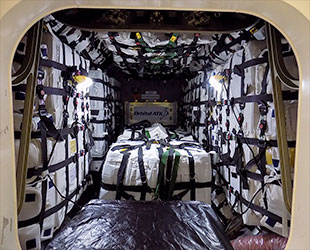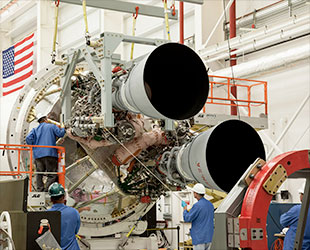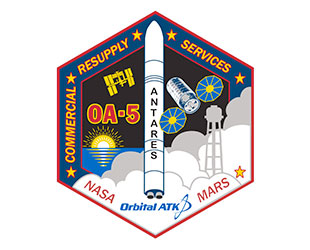October 17, 2016 — A U.S. commercial rocket launched an uncrewed cargo craft to the International Space Station Monday evening (Oct. 17), marking the booster's return to flight after almost exactly two years.
Orbital ATK's Antares rocket lifted off from the Mid-Atlantic Regional Spaceport's (MARS) Pad 0-A at NASA's Wallops Flight Facility on the eastern shore of Virginia at 7:45 p.m. EDT (2345 GMT). The launch debuted the first use of the company's redesigned Antares rocket since a catastrophic anomaly destroyed an earlier version of the booster and its Cygnus resupply vehicle just seconds into flight in October 2014.
"This is a very exciting time for us," said Frank Culbertson, Orbital ATK Space Systems Group president and a former NASA astronaut, in a preflight press briefing. "A lot of hard work has gone into this."
The launch put Orbital ATK's seventh Cygnus – named the "S.S. Alan Poindexter" after the space shuttle commander who died in 2012 — on track to rendezvous with the space station, although it will wait to approach to the outpost until after Russia's crewed Soyuz MS-02 spacecraft docks with the station on Friday, pending its launch on Wednesday.
The Cygnus freighter is carrying 5,346 pounds (2,425 kg) of supplies and research equipment for the space station's 49th and 50th expeditions, including the crew members on the arriving Soyuz.

View of the cargo packed inside the S.S. Alan Poindexter Cygnus spacecraft bound for the International Space Station. (Orbital ATK) |
"The International Space Station program is glad to be at Wallops. We have missed seeing the launches from here," Joel Montalbano, the deputy manager for the space station program at NASA's Johnson Space Center, said.
Since the failed launch on Oct. 28, 2014, which ended in a massive fireball just 15 seconds into flight, Orbital ATK has redesigned the Antares rocket to replace its two first stage, Soviet-era AJ-26 engines with new Russian-produced RD-181 engines.
The AJ-26, also known as the NK-33, was first developed for the Soviet Union's N-1 moon booster. An investigation attributed the loss of the Antares to an explosion inside the liquid oxygen turbopump of one of the two AJ-26 engines.
"The most significant upgrade we've made to the vehicle is the new RD-181 engine," said Mike Pinkston, Orbital ATK Antares program vice president and general manager. "We did have to make some changes to the structures that are used to transfer the thrust loads from the engines to the core propellant tanks, [but] the core structure was largely unchanged, aided greatly by how close a match the two engines were in some of their key characteristics."

Orbital ATK engineers install two Energomash RD-181 engines on its Antares rocket's core structure in July 2015. (NASA) |
The new engines provided a quicker trip for the Cygnus to orbit on Monday.
"Because of the higher performing engine ... we will have Cygnus in orbit about a minute earlier than we would have on a previous version Antares," Pinkston noted in the pre-flight briefing on Sunday.
On Sunday (Oct. 23), the Cygnus will approach the space station and the crew will use the Canadarm2 robotic arm to capture and mount the ship to the side of the Unity node. They will then spend the next month unpacking the vehicle of its cargo, including the hardware needed to investigate "cool flames," a phenomenon observed with some types of fuels that initially burn hot and then appear to extinguish, but continue to burn at a much lower temperature with no visible flames.
The S.S. Alan Poindexter is also delivering an educational outreach experiment that uses an off-the-shelf, commercial Sphero robot to advance students' interest in coding. (The Sphero is made by the same company that has sold the popular "Star Wars" BB-8 version of the programmable toy robot.)
"Every cargo mission is like Christmas, right?" Culbertson said. "[The station's crew] never knows what they will find when they open the hatch."

OA-5 patch for the S.S. Alan Poindexter's mission. (Orbital ATK) |
After being emptied of its "presents," refilled with trash and departing the station, the Cygnus will serve for its second time as a platform for SAFFIRE, a large-scale combustion experiment developed by NASA to study flammability and fire propagation in space.
The Cygnus will also release several small Spire Cubesats used for weather forecasting using an externally-mounted, commercial NanoRack deployer.
Alan Poindexter, the late astronaut who was posthumously honored with the christening of the OA-5 mission Cygnus, helped to install the European Columbus laboratory on the space station in 2008 and commanded a cargo mission to resupply the outpost in 2010.
"We think it is very fitting that Alan is the namesake for this particular Cygnus. We are very honored to have his name and picture as a part of this spacecraft," Culbertson said.
